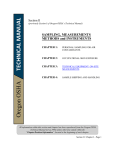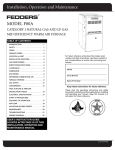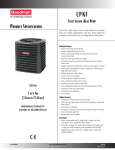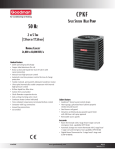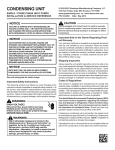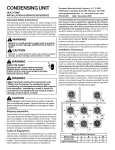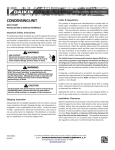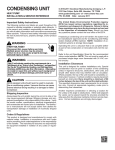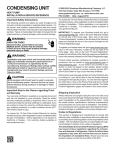Download Amana CKF60 Operating instructions
Transcript
2010-2011 Goodman Manufacturing Company, L.P. SPLIT SYSTEM OUTDOOR UNIT © 5151 San Felipe, Suite 500, Houston, TX 77056 CKL , CKF, CPKF SERIES INSTALLATION & OPERATING INSTRUCTIONS IMPORTANT SAFETY INSTRUCTIONS The following symbols and labels are used throughout this manual to indicate immediate or potential safety hazards. It is the owner’s and installer’s responsibility to read and comply with all safety information and instructions accompanying these symbols. Failure to heed safety information increases the risk of personal injury, property damage, and/or product damage. Prior to installation, thoroughly familiarize yourself with this installation manual. Observe all safety warnings. During installation or repair, caution is to be observed. It is the responsibility of the installing personnel to install the product safely and to educate the customer on its safe use. HIGH VOLTAGE! Disconnect ALL power before servicing. Multiple power sources may be present. Failure to do so may cause property damage, personal injury or death. Installation and repair of this unit should be performed ONLY by individuals meeting the requirements of an “entry level technician” as specified by National Codes. Attempting to install or repair this unit without such background may result in product damage, personal injury or death. Do not connect to or use any device that is not designcertified by Goodman for use with this unit. Serious property damage, personal injury, reduced unit performance and/or hazardous conditions may result from the use of such non-approved devices. Shipping Inspection Always keep the unit upright; laying the unit on its side or top may cause equipment damage. Shipping damage, and subsequent investigation is the responsibility of the carrier. Verify the model number, specifications, electrical characteristics, and accessories are correct prior to installation. The distributor or manufacturer will not accept claims from dealers for transportation damage or installation of incorrectly shipped units. Codes & Regulations This product is designed and manufactured to comply with national codes. Installation in accordance with such codes and/or prevailing local codes/regulations is the responsibility of the installer. The manufacturer assumes no responsibility for equipment installed in violation of any codes or regulations. www.goodmanmfg.com -or- www.amana-hac.com P/N: IO-382C Date: September 2011 Handling of refrigerant may be governed by various regulations regarding the introduction and disposal of refrigerants. Failure to follow these regulations may harm the environment and can lead to the imposition of substantial fines. Should you have any questions please contact the local office of the regulatory agency in your countries. Replacement Parts When reporting shortages or damages, or ordering repair parts, give the complete product model and serial numbers as stamped on the product. Replacement parts for this product are available through your contractor or local distributor. For the location of your nearest distributor consult the white business pages, the yellow page section of the local telephone book or contact: CONSUMER AFFAIRS GOODMAN MANUFACTURING COMPANY, L.P. 7401 SECURITY WAY HOUSTON, TEXAS 77040 877-254-4729 NOTE: Information contained in this manual pertains only to equipment intended for outdoor installation. For additional information refer to literature packaged with other system components. Pre-Installation Instructions Carefully read all instructions for the installation prior to installing product. Make sure each step or procedure is understood and any special considerations are taken into account before starting installation. Assemble all tools, hardware and supplies needed to complete the installation. Some items may need to be purchased locally. Make sure everything needed to install the product is on hand before starting. INSTALLATION AND OPERATING INFORMATION FOR UNITS WITH SCROLL COMPRESSORS CAUTION Use care when handling scroll compressors. Dome temperatures could be hot. The following information should be read prior to installing units with scroll compressors. 1. PUMP DOWN PROCEDURE CAUTION 2. CRANKCASE HEATER Scroll equipped units do not have and do not require a crankcase heater. 3. TIME DELAY COMPONENT The time delay is located in the low voltage control circuit. When the compressor shuts off due to thermostat operation or a power failure, this components keeps the compressor off for at least 30 seconds which allows the system pressure to equalize. 4. UNBRAZING SYSTEM COMPONENTS If the refrigerant charge is removed from a scroll equipped unit by bleeding the high side only, it is sometimes possible for the scrolls to seal, preventing pressure equalization through the compressor. This may leave the low side shell and suction line tubing pressurized. If a brazing torch is then applied to the low side while the low side shell and suction line contains pressure, the pressurized refrigerant and oil mixture could ignite when it escapes and contacts the brazing flame. To prevent this occurrence , it is important to check both the high and low side with manifold gauge before unbrazing, bleed refrigerant from both the high and low side. such a manner that the discharge of the mower will be directed away from the unit. There must be air filters installed in the system at some point upstream to the indoor coil. Air filters should be inspected and, if necessary, replaced and/ or cleaned AT LEAST once a month. If disposable filters are used, an adequate supply of clean, unused filters of the correct size should be kept available. Equipment should never be operated without filters. Permanent type filters may be vacuumed and/or washed but should not be reinstalled until thoroughly dry. Most air filters are marked to indicate the direction of air flow, and this should be carefully noted when they are being installed. Never turn a dirty filter to allow air flow in the opposite direction. The blower and motor bearings are permanently lubricated and do not require additional lubrication. EQUIPMENT Some outdoor units have corresponding heaters that are factory wired in such a manner that they are in operation whenever the main power supply to the unit is on. Before starting equipment after prolonged shutdowns or at the time of initial start up, be sure that the circuits to the units are closed for at least 24 hours. IMPORTANT MESSAGE TO OWNER: These instructions should be carefully read and kept for future reference. It is suggested that this booklet be saved for future references. It is addressed to your dealer and serviceman, but we highly recommend you read it, paying particular attention to the section titled MAINTENANCE. APPLICATION It is not the intent of the manufacturer that this equipment be used with components other than indicated. The manufacturer assumes no responsibility for equipment installed in violation of any code or regulation. The manual will instruct you in the service and care of your unit. Have your installer go over the manual with you so that you fully understand your air conditioner and how it is intended to function. Do not connect to or use any device that is not designcertified by Goodman for use with this unit. Serious property damage, personal injury, reduced unit performance and/or hazardous conditions may result from the use of such non-approved devices. The heat pump is a relatively simple device. It operates exactly as a summer air conditioning unit on the cooling cycle. Always let the thermostat control system operation. Do Not try to second guess the thermostat or tamper with it. If the conditioned area temperature is not suitable, change the thermostat setting one degree at a time until desired comfort level is achieved. Reference Specification Sheets For Performance Values And Approved System Matches. LOCATION The outdoor unit should be located so that air flow through the coil is unrestricted. To provide adequate service access, do not locate service side closer than 30.5 cm to any wall or obstruction. A heat pump in the heating mode cannot heat a building as rapidly as a furnace heats it. It may take a day or two to “pull down” a cold, moist house when the unit is initially installed or after prolonged shutdowns. Consider the affect of outdoor fan noise on conditioned space and any adjacent occupied space. It is recommended that the unit be placed so that discharge does not blow toward windows less than 7.6 m away. MAINTENANCE It is recommended that the outdoor unit be inspected and, if necessary, cleaned each cooling season. Particular attention should be given to the air inlet side of the outdoor coil to insure that leaves, grass, etc., are not being drawn into the unit. Restriction to air flow across the coil will result in loss of system capacity, high operating pressures and excessive operating costs. If the outdoor unit is installed adjacent to a grassy area, it is suggested that lawn mowers be routed in The outdoor unit should be set on a solid, level foundation preferably a concrete slab at least 10.2 cm thick. The slab should be above ground level and surrounded by a graveled area for good drainage. Any slab used as a unit foundation should not adjoin the building as it is possible that sound and vibration may be transmitted to the structure. For rooftop installation, steel or treated wood beams should be used as unit support for load distribution. 2 This equipment has been started at minimum rated voltage and checked for satisfactory operation. Do not attempt to operate this unit if available voltage is not within the minimum and maximum shown on nameplate. Heat pumps require special location consideration in areas of heavy snow accumulation and/or areas with prolonged continuous subfreezing temperatures. Heat pump unit bases are cutout under the outdoor coil to permit drainage of frost accumulation. Units must be situated to permit free unobstructed drainage of the defrost water and ice. A minimum 7.6 cm clearance under the outdoor coil is required in the milder climates. NOTE: Units are shipped without refrigerant and are pressurized with a nitrogen holding charge of 125 PSI. This charge must be removed and unit evacuated and charged as per the installation instructions. Release holding charge by opening the suction valve first then the liquid line valve before attaching and brazing lines. When opening valves with retainers, open each valve only until the top of the stem is 1/8" from the retainer. To avoid loss of refrigerant, DO NOT apply pressure to the retainer. When opening valves without a retainer remove service valve cap and insert a hex wrench into the valve stem and back out the stem by turning the hex wrench counterclockwise. Open the valve until it contacts the rolled lip of the valve body. NOTE: These are not back-seating valves. It is not necessary to force the stem tightly against the rolled lip. In more severe weather locations, it is recommended that units be elevated to allow unobstructed drainage and air flow. While there are no hard and fast rules regarding elevation, we suggest the following minimums: If the outdoor unit is mounted above the air handler, the maximum lift should not exceed 21.3 m (suction line). If air handler is mounted above condensing unit, the lift should not exceed 15.2 m (liquid line). Insulation of at least 1.3 cm wall thickness should be used on the suction line to prevent condensation when cooling and heat loss when heating. The insulation should be installed on the tubing prior to installation and should be run the entire length of the installed line. The end of the tubing over which the insulation is being slipped should be covered to insure that no foreign material is introduced to the interior of the tubing. The outdoor units are equipped with two service valves, and, “as shipped”, the valves are in the front-seated or “closed” position. The indoor coil is pressurized; the copper cap must be punctured to permit a gradual escape of the pressure prior to un-sweating those caps. Immediately couple the tubing to the indoor unit to minimize exposing the coils to moisture. - REFRIGERANT LINE CONNECTIONS IMPORTANT To avoid overheating the service valves or expansion device while brazing, wrap the component with a wet rag, or use a thermal heat trap compound. Be sure to follow the manufacturer’s instruction when using the heat trap compound. NOTE: Remove Schrader valves from service valves before brazing tubes to the valves. Use a brazing alloy of 2% minimum silver content. Do not use flux. Torch heat required to braze tubes of various sizes is proportional to the size of the tube. Tubes of smaller size require less heat to bring the tube to brazing temperature before adding brazing alloy. Applying too much heat to any tube can melt the tube. Service personnel must use the appropriate heat level for the size of the tube being brazed. NOTE: The use of a heat shield when brazing is recommended to avoid burning the serial plate or the finish of the unit. INSTALLATION, ELECTRICAL The supply power, voltage, frequency and phase must coincide with that on unit nameplate. All wiring should be carefully checked against the manufacturer’s diagrams. Field wiring must be connected in accordance with the National Electric Code or other local codes that may apply. Make certain that the equipment is adequately grounded per local code requirements. The manufacturer bears no responsibility for damage caused to equipment or property as a result of the use of larger than recommended size protective devices as listed on the unit rating plate. 3 NOTE: Be careful not to kink or dent refrigerant lines. Kinked or dented lines will cause poor performance or compressor damage. Do NOT make final refrigerant line connection until plugs are removed from refrigerant tubing. 2. Evacuate the system to 250 microns or less using suction and liquid service valves. Using both valves is necessary as some compressors create a mechanical seal separating the sides of the system. 3. Close pump valve and hold vacuum for 10 minutes. Typically pressure will rise during this period. • If the pressure rises to 1000 microns or less and remains steady the system is considered leak-free; proceed to startup. 1. The ends of the refrigerant lines must be cut square, deburred, cleaned, and be round and free from nicks or dents. Any other condition increases the chance of a refrigerant leak. 2. “Sweep” the refrigerant line with nitrogen or inert gas during brazing to prevent the formation of copper-oxide inside the refrigerant lines. A blockage or failure of the metering device could result if copper-oxide is flushed into the metering device. 3. After brazing, quench the joints with water or a wet cloth to prevent overheating of the service valve. REFRIGERANT LINE LENGTH (METERS) 0-7.5 Suct 15.9 19.1 19.1 19.1 19.1 22.2 22.2 7.6-15.1 15.2-22.6 Line Diameter OD (mm) Liq Suct Liq Suct Liq 6.4 19.1 9.5 19.1 9.5 9.5 19.1 9.5 19.1 9.5 9.5 *19.1 9.5 22.2 12.7 9.5 22.2 9.5 22.2 12.7 9.5 22.2 9.5 28.6 12.7 9.5 28.6 9.5 28.6 12.7 9.5 28.6 9.5 28.6 12.7 • If pressure rises above 1000 microns but holds steady below 2000 microns, moisture and/or non-condensibles may be present or the system may have a small leak. Return to step 2: If the same result is encountered check for leaks as previously indicated and repair as necessary then repeat evacuation. • If pressure rises above 2000 microns, a leak is present. Check for leaks as previously indicated and repair as necessary. • If pressure rises above 2000 microns, a leak is present. Check for leaks as previously indicated and repair as necessary then repeat evacuation. > > Cond Unit Tons 1 1/2 2 2 1/2 3 3 1/2 4 5 * - 19.1 mm REQUIRED FOR FULL RATINGS ^ - 22.2 mm REQUIRED FOR FULL RATINGS 4. Ensure the filter drier paint finish is intact after brazing. If the paint of the steel filter drier has been burned or chipped, repaint or treat with a rust preventative. This is especially important on suction line filter driers which are continually wet when the unit is operating. System Start Up When opening valves with retainers, open each valve only until the top of the stem is 1/8" from the retainer. To avoid loss of refrigerant, DO NOT apply pressure to the retainer. When opening valves without a retainer remove service valve cap and insert a hex wrench into the valve stem and back out the stem by turning the hex wrench counterclockwise. Open the valve until it contacts the rolled lip of the valve body. NOTE: These are not back-seating valves. It is not necessary to force the stem tightly against the rolled lip. Open the suction service valve first! If the liquid service valve is opened first, oil from the compressor may be drawn into the indoor coil TXV, restricting refrigerant flow and affecting operation of the system. After the refrigerant charge has bled into the system, open the liquid service valve. The service valve cap is the secondary seal for the valves and must be properly tightened to prevent leaks. Make sure cap is clean and apply refrigerant oil to threads and sealing surface on inside of cap. Tighten cap finger-tight and then tighten additional 1/6 of a turn (1 wrench flat), or to the following specification, to properly seat the sealing surfaces. NOTE: Before brazing, verify indoor piston size by checking the piston kit chart packaged with indoor unit. Leak Testing (Nitrogen or Nitrogen-Traced) Pressure test the system to approximately 100 PSI with dry nitrogen and use soapy water to locate leaks. If you wish to use a leak detector, charge the system to 10 psi using the appropriate refrigerant then use nitrogen to finish charging the system to working pressure then apply the detector to suspect areas. If leaks are found, repair them. After repair, repeat the pressure test. If no leaks exist, proceed to system evacuation. System Evacuation NOTE: Scroll compressors should never be used to evacuate or pump down a heat pump or air conditioning system. 1. Connect the vacuum pump with 250 micron capability to the service valves. 4 1. 3/8" valve to 5 - 10 in-lbs (0.56-1.30 Nm) 2. 5/8" valve to 5 - 20 in-lbs (0.56-2.26 Nm) 3. 3/4" valve to 5 - 20 in-lbs (0.56-2.26 Nm) 4. 7/8" valve to 5 - 20 in-lbs (0.56-2.26 Nm) Airflow Determination - Indoor Coil The heat pump system has been designed for optimum performance with the airflow across the indoor coil equaling approximately 190 L/s per TON. e.g. A 2 TON system should have 2 x 190 = 380 L/s. Do not introduce liquid refrigerant from the cylinder into the crankcase of the compressor as this may damage the compressor. Temperature Rise Method - Although not as accurate as the use of test equipment, a method of determining the indoor airflow in a system employing electric resistance heat as the backup heat source is by the temperature rise method and is calculated using the following formula: 1. Purge gauge lines after attaching to the service valves. 2. Determine the proper charge from the serial data plate. Charge includes the evaporator coil and 7.6 m of line set. Systems having more than 7.6 m of interconnecting tubing require an additional charge allowance of 6 oz. 3. Break the vacuum by opening the suction and liquid valves on the gauge set and weighing in the calculated charge. 4. Set thermostat to call for cooling. Check indoor and outdoor fan operation and allow system to stabilize for 10 minutes for fixed orifices. 828.3 x Input Power (kW) Air Flow (L/s) = Temperature Rise (°C) where measured input voltage (Volt) x current (Amp) kW = 1000 e.g. input voltage = 230 Volt, measured current 35 amps temperature rise = 12°C FINAL CHARGE ADJUSTMENT The outdoor temperature must be 60°F (16°C) or higher. Set the room thermostat to COOL, fan switch to AUTO, and set the temperature control well below room temperature. After system has stabilized per startup instructions, check superheat as detailed in the following section. air flow = 828.3 * 230 * 35 / 1000 / 12 = 556 (L/s) NOTE: The compressor circuit (outdoor unit) must be off to insure that the Temperature Rise measured across the indoor unit is due only to the electric heat. GENERAL: The following information has been developed to assist the service technician in determining the proper charge for Goodman® Heat Pump Systems. The following procedure should be followed in determining the temperature rise across the indoor section: It must be noted that many field variations exist that may effect the operating temperature and pressure readings of a heat pump system. It should also be noted that all Goodman® Heat Pump Systems utilize fixed orifice refrigerant control devices. As such, the following procedures have been developed for this type of refrigerant control device. 1. Use the same thermometer for the measuring the return and supply air temperatures to avoid thermometer error. 2. Measure the temperatures within 1.8 meters of the indoor section and downstream from any mixed air source making sure that the thermometer is not exposed to any radiant heat areas. I. DETERMINATION OF INDOOR AIR FLOW (L/S) AND HEATING CAPACITY (KW) 3. Make sure that the air temperature is stable before making measurement. Prior to using the methods described below to check the system’s charge it is important to verify that the system is delivering sufficient air across the indoor coil (L/s, liters per second), as well as, the operating capacity of the system. The following procedures are suggested methods for determining the system air flow (L/s) and its operating capacity (kW). Airflow Test Instruments - There are a number of readily available instruments which can be used in the field for airflow determination such as Barometers, Volume-Aire Air Balancers, Anemometers, and Velometers. When using these devices it is important to follow the manufacture’s instructions provided with them. 5 1. Use the same procedure described above to determine system Airflow and temperature rise across the indoor section. DO NOT MEASURE IN RADIANT HEAT AREA SUPPLY 2. Referring to Table I, determine the power output of the system for the measured Temperature Rise and system air flow, or by use of the following formula: HEATER MEASURE Airflow (L/s) x Temperature Rise (°C) ΔΤ Power (kW) = 828.3 AIRHANDLER II. REFRIGERANT CHARGE DETERMINATION AND ADJUSTMENT RETURN WARNING To avoid possible injury, explosion or death, practice safe handling of refrigerants. FIGURE COOLING CYCLE: The method to insure that the heat pump/cooling system is properly charged is by weighing in the amount of refrigerant specified on the outdoor sections nameplate, with additional adjustments for line size, line length, and other system components. DETERMINATION OF HEATING CAPACITY - HEAT PUMP ONLY The temperature rise method described above can be used to determine the heating capacity of the heat pump system in the heat pump “only” mode. The results obtained using this method should agree to within 10% of the data published in the specification sheets for the combination of indoor and outdoor section. SYSTEMS WITH MORE THAN 7.6 METERS OF REFRIGERANT LINE REFRIGERANT Allowance Systems having more than 7.6 m of interconnecting refrigerant lines require an additional charge allowance of R22 per Table II. Note - When using the following procedure to determine the system’s capacity make sure that the indoor sections backup heat source is de-energized. HEAT OUTPUT KW 3 4 5 6 7 8 9 10 11 12 13 14 15 16 17 18 19 20 2 0 0 2 5 0 3 0 0 3 5 0 4 0 0 12.4 16.6 20.7 24.8 29.0 33.1 37.3 41.4 45.6 49.7 9.9 13.3 16.6 19.9 23.2 26.5 29.8 33.1 36.4 39.8 43.1 46.4 49.7 8.3 11.0 13.8 16.6 19.3 22.1 24.8 27.6 30.4 33.1 35.9 38.7 41.4 44.2 46.9 49.7 7.1 9.5 11.8 14.2 16.6 18.9 21.3 23.7 26.0 28.4 30.8 33.1 35.5 37.9 40.2 42.6 45.0 47.3 6.2 8.3 10.4 12.4 14.5 16.6 18.6 20.7 22.8 24.8 26.9 29.0 31.1 33.1 35.2 37.3 39.3 41.4 AIRFLOW – Liters per second (L/s) 4 5 5 6 6 7 7 8 8 5 0 5 0 5 0 5 0 5 0 0 0 0 0 0 0 0 0 9 0 0 9 5 0 1 0 0 0 1 0 5 0 1 1 0 0 1 1 5 0 1 2 0 0 1 2 5 0 7.4 8.3 9.2 10.1 11.0 12.0 12.9 13.8 14.7 15.6 16.6 17.5 18.4 7.8 8.7 9.6 10.5 11.3 12.2 13.1 14.0 14.8 15.7 16.6 17.4 7.5 8.3 9.1 9.9 10.8 11.6 12.4 13.3 14.1 14.9 15.7 16.6 7.9 8.7 9.5 10.3 11.0 11.8 12.6 13.4 14.2 15.0 15.8 7.5 8.3 9.0 9.8 10.5 11.3 12.0 12.8 13.6 14.3 15.1 7.9 8.6 9.4 10.1 10.8 11.5 12.2 13.0 13.7 14.4 7.6 8.3 9.0 9.7 10.4 11.0 11.7 12.4 13.1 13.8 8.0 8.6 9.3 9.9 10.6 11.3 11.9 12.6 13.3 TEMPERATURE RISE (°C) 7.4 9.2 11.0 12.9 14.7 16.6 18.4 20.2 22.1 23.9 25.8 27.6 29.5 31.3 33.1 35.0 36.8 6.6 8.3 9.9 11.6 13.3 14.9 16.6 18.2 19.9 21.5 23.2 24.8 26.5 28.2 29.8 31.5 33.1 7.5 9.0 10.5 12.0 13.6 15.1 16.6 18.1 19.6 21.1 22.6 24.1 25.6 27.1 28.6 30.1 6.9 8.3 9.7 11.0 12.4 13.8 15.2 16.6 17.9 19.3 20.7 22.1 23.5 24.8 26.2 27.6 7.6 8.9 10.2 11.5 12.7 14.0 15.3 16.6 17.8 19.1 20.4 21.7 22.9 24.2 25.5 6 7.1 8.3 9.5 10.6 11.8 13.0 14.2 15.4 16.6 17.7 18.9 20.1 21.3 22.5 23.7 7.7 8.8 9.9 11.0 12.1 13.3 14.4 15.5 16.6 17.7 18.8 19.9 21.0 22.1 7.2 8.3 9.3 10.4 11.4 12.4 13.5 14.5 15.5 16.6 17.6 18.6 19.7 20.7 7.8 8.8 9.7 10.7 11.7 12.7 13.6 14.6 15.6 16.6 17.5 18.5 19.5 4. Determine the systems superheat as follows: NOTE - When installing systems were the indoor outdoor sections are separated by more than 7.6 meters, note the maximum elevation separation limitations per the diagram in the LOCATION section of these instructions. Allowance LINE O. D. (mm) 6.4 9.5 12.7 15.9 19.1 22.2 28.6 34.9 (R-22) LIQUID LINE 20.5 54.0 106.0 173.0 a. Read the system’s suction pressure, then using Table III determine the system’s saturated suction tempera ture. gram/meter 20.5 b. Read the suction line temperature. c. The system’s superheat = the suction line tempera ture - the saturated liquid temperature. SUCTION LINE SUCTION PRESSURE KPa 345 365 380 400 420 435 455 475 495 515 540 560 3.8 5.6 7.4 14.0 20.5 TABLE II - Line Charge SUPERHEAT METHOD : 1. With both base valves fully open, connect a set of service gauges to the base valves’ service port, being careful to purge the lines. SATURATED SUCTION TEMPERATURE °C -3.3 -2.2 -1.1 0 1.1 2.2 3.3 4.4 5.6 6.7 7.8 8.9 2. Allow the system to operate at least 10 minutes or until the pressures stabilize. TABLE III - Saturated Suction Pressure (R-22) 3. Temporarily install a thermometer on the suction (large) line near the condensing unit’s base valve. Make sure that there is good contact between the thermometer and the refrigerant line and wrap the thermometer and line with insulating tape to assure accurate readings. 5. Refer to Table IV for the proper system superheat. Adjust the charge as necessary by adding charge to lower the superheat or bleeding the charge to raise the superheat. SYSTEM SUPERHEAT Ambient Condenser Inlet Temperature ( °C Drybulb ) Return Air Temperature ( 50%RH ) Drybulb Wetbulb Drybulb Wetbulb Drybulb Wetbulb Drybulb Wetbulb Drybulb Wetbulb 18º 12º 21º 14º 24º 17º 27º 19º 29º 22º 46 --- --- --- --- 3 38 --- --- --- 3 3 35 --- --- 3 3 32 --- --- 3 6 6 29 --- 3 3 7 9 27 3 3 3 10 11 24 3 3 6 11 12 21 3 3 8 13 14 18 3 6 11 14 16 16 4 8 12 16 17 NOTE: * Charge 3° super heat, all other could be ± 1.1°C TABLE IV - System Superheat 7 * 5 6. Remove the service gauge set’s lines carefully - Escaping liquid refrigerant can cause burns. 12. If unit operates properly on the heating cycle, raise the heating temperature setting high enough until the heating second-stage mercury bulb (lower) makes contact. CAUTION 13. Supplementary resistance heat, if installed, should now come on. Make sure it is operating correctly. If outdoor thermostats are installed, the outdoor ambient must be below the set point of these thermostats for heaters to operate. It may be necessary to jumper these thermostats to check heater operation if outdoor ambient is mild. To prevent personal injury, carefully connect and disconnect manifold gauge hoses. Escaping liquid refrigerant can cause burns. Do not vent refrigerant into the atmosphere. Recover all refrigerant during system repair and before final unit disposal. 14. For thermostats with emergency heat switch, return to startup (item #9). The emergency heat switch is located at the bottom of the thermostat. Move this switch to emergency heat. The heat pump will stop, the indoor blower will continue to run, all heaters will come on and the thermostat emergency heat light will come on. HEAT PUMP HEATING CYCLE Weighing In Charge As in the cooling mode the proper method of insuring that the system is properly charged is by weight with the additional charge adjustments for line size, line length, and other system components as previously indicated. STARTUP PROCEDURE AND CHECK LIST Begin with power turned off at all disconnects. 15. If checking the unit on the heating cycle in the wintertime, when the outdoor coil is cold enough to actuate the defrost control, observe at least one defrost cycle to make sure the unit defrosts properly. 1. Set first-stage thermostat heat anticipator to .12 (amps) and turn thermostat system switch to “Cool” and fan switch to “Auto”. 16. Check to see if all supply and return air grilles are adjusted and air distribution system is balanced for the best compromise between heating and cooling. 2. Turn cooling temperature setting as high as it will go. 17. Check for air leaks in the ductwork. 3. Inspect all registers and set them to the normal open position. 18. Make sure the heat pump is free of “rattles”, and the tubing in the unit is free from excessive vibration. Also make sure lines are not rubbing against each other or sheet metal surfaces or edges. If so, correct the trouble. 4. Turn on the unit electrical supply at the fused disconnect switch, both for the indoor unit and the outdoor unit. 19. Set thermostat at the appropriate setting for cooling and heating or automatic changeover for normal use. 5. Turn the fan switch to the “On” position. The blower should operate 10 to 15 seconds later. 20. Be sure the owner is instructed on the unit operation, filter servicing, correct thermostat operation, etc. 6. Turn the fan switch to the “Auto” position. The blower should stop 90 seconds later. The foregoing “Start-up Procedure and Check List” is recommended to serve as an indication that the heat pump system will operate normally. Note: If outdoor temperature is below 12.8°C, proceed to step 9. Do not check out in the cooling mode. 7. Slowly lower the cooling temperature until the first mercury bulb makes contact. The compressor, indoor blower, and outdoor fan should now be running. Make sure cool air is supplied by the unit. COMPONENTS: 1. Contactor - This control is activated (closed) by the room t-stat for both heating and cooling. It is de-energized (open) during emergency heat. The contactor has a 24 volt coil and supplies power to the compressor and outdoor fan motor. 8. Turn system switch to “Heat” and fan switch to “Auto”. 9. Slowly raise the heating temperature setting. After the heating first-stage mercury bulb (upper) makes contact, stop moving the lever. The compressor, indoor blower and outdoor fan should now be running. After giving the unit time to settle out, make sure heated air is being supplied by the indoor unit. 2. Crankcase Heater - This item is on whenever power is supplied to the outdoor unit. It warms the compressor crankcase, thereby preventing liquid migration and subsequent compressor damage. It is connected electrically to the contactor L1 and L2 terminals. 10. If the outdoor ambient is above 21.1°C, the compressor may trip on internal overload. 3. Condenser motor - The condenser motor is activated by the contactor during heating and cooling except during defrost and emergency heat operation. 11. In the event that the outdoor ambient is too high to allow a thorough heating cycle check, postpone the test until another day when conditions are more suitable...but — DO NOT FAIL TO TEST. 4. Compressor - This item is activated by the contactor for heating and cooling except during emergency heat. It is protected by an internal overload. 8 G. When the defrost thermostat has closed, short the “test” pins on the board until the reversing valve shifts, indicating defrost. This could take up to 21 seconds depending on what timing period the board is set on. After defrost initiation, the short must instantly be removed or the defrost period will only last 2.3 seconds. 5. Defrost Control - The defrost control provides time/ temperature initiation and termination of the defrost cycle. 6. Loss Of Charge Protector - The control opens from its normally closed position to open the compressor contactor should the system lose its refrigerant charge. 7. Outdoor Thermostats - These optional controls are used to prevent full electric heater operation at varying outdoor ambient (-17.8 to 7.2°C). They are normally open above their set points and closed below to permit staging of indoor supplemental heater operation. H. After the defrost has terminated, check the defrost thermostat for 24 volts between “DFT” and “C”. The reading should indicate 0 volts (open sensor). I. Shut off power to unit. J. Replace outdoor fan motor lead and turn on power. 8. Reversing Valve Coil - This coil is activated by the thermostat (system switch) during cooling only and during defrost. It positions the reversing valve pilot valve for cooling operation. OPERATION - GENERAL EXPLANATION AND GUIDANCE The heat pump is a relatively simple device. It operates exactly as a Summer Air Conditioning unit when it is on the cooling cycle. Therefore, all the charts and data for service that apply to summer air conditioning apply to the heat pump when it is on the cooling cycle, and most apply on the heating cycle except that “condenser” becomes “evaporator”, “evaporator” becomes “condenser” and “cooling” becomes “heating”. OPERATION: In operation the power to the circuit board is controlled by a temperature sensor which is clamped to a return bend on the outdoor coil. Timing periods of 30, 60, or 90 minutes may be selected by connecting the circuit board jumper wire to 30, 60, 90 respectively. Accumulation of time for the timing period selected starts when the sensor closes (approximately -2.2°C) and when the wall thermostat is calling for heat. At the end of the timing period, a defrost cycle will be initiated provided the sensor remains closed. When the heat pump is on the heating cycle, it is necessary to redirect the refrigerant flow through the refrigerant circuit external to the compressor. This is accomplished with a reversing valve. Thus, the hot discharge vapor from the compressor is directed to the inside coil (evaporator on the cooling cycle) where the heat is removed, and the vapor condenses into liquid. It then goes through a capillary tube, or expansion valve, to the outside coil (condenser on the cooling cycle) where the liquid is evaporated, and vapor goes to the compressor. When the sensor opens (approximately 18.3°C), the defrost cycle is terminated. If the defrost cycle is not terminated due to the sensor temperature, a 10 minute override interrupts the defrost period. When the solenoid valve is operated either from heating to cooling or vice versa, it moves the pilot valve, thus putting suction pressure (low pressure) on one side of the piston of the reversing valve, and since discharge pressure (high pressure) is on the other side of the piston, the piston slides to the low pressure side and reverses the flow of the refrigerant in the circuit. SUGGESTED FIELD TESTING / TROUBLE SHOOTING A. Run unit in heat mode. B. Check unit for proper charge. Note: Bands of frost indicate low refrigerant charge C. Shut off power to unit. D. Disconnect outdoor fan by removing the purple lead from “DF2” on defrost control. E. Restart unit and allow frost to accumulate. F. After a few minutes of operation, the defrost thermostat should close. To verify this, check for 24 volts between “DFT” and “C” on board. If the temperature at the thermostat is less than -2.2°C and the thermostat is open, replace the thermostat as it is defective. 9 When the heat pump is on the heating cycle, at which time the outdoor coil is functioning as an evaporator, the temperature of the refrigerant in the outdoor coil must be below the temperature of the outdoor air in order for the refrigerant in the outdoor coil to extract heat from the air. Thus, the greater the difference in outdoor temperature and outdoor coil temperature, the greater the heating capacity of the heat pump. Since this is characteristic of heat pumps, it is good practice to provide supplementary heat for all heat pump installations in areas where the temperature drops below 7.2°C. It is also good practice to provide sufficient supplementary heat to handle the entire heating requirements if there should be a failure of heat pump, such as a compressor failure, or refrigerant leak, etc. The following figures show a schematic of a heat pump on the cooling cycle and the heating cycle Heat Pump Refrigerant Circuit Since the temperature of the liquid refrigerant in the outdoor coil on the heating cycle is generally below the freezing point, frost forms on the surfaces of the outdoor coil under certain weather conditions of temperature and relative humidity, Therefore, it is necessary to reverse the flow of the refrigerant to provide hot gas in the outdoor coil to melt the frost accumulation. This is accomplished by reversing the heat pump to the cooling cycle. At the same time, the outdoor fan stops to hasten the temperature rise of the outdoor coil and lessen the time required for defrosting. The indoor blower continues to run and the supplementary heaters are energized. SERVICE: The following information is for use by qualified service agency only; others should service this equipment. Common Causes of Unsatisfactory Operation of Heat Pumps on the Heating Cycle. A. Dirty Filters or inadequate air volume through indoor coil. When the heat pump is on the heating cycle, the indoor coil is functioning as a condenser; therefore, the filters must always be clean, and sufficient air volume must pass through the indoor coil to prevent excessive discharge pressure and high pressure cut-out. nI B. Outside Air into Return Duct: Cold outside air should not be introduced in the return duct of a heat pump installation on the heating cycle close enough to the indoor coil to reduce temperature of the air entering the coil below 18.3°C. Air below this temperature will cause low discharge pressure, thus low suction pressure and excessive defrost cycling with resultant low heating output. It may also cause false defrosting. In addition to a reversing valve, a heat pump is equipped with an expansion device and check valve for the inside coil, and similar equipment for the outside coil. It is also provided with a defrost control system. C. Undercharge: Undercharge on the heating cycle will cause low discharge pressure resulting in low suction pressure and frost accumulation on the lower part of the outdoor coil. The expansion device performs the same function on the heating cycle as on the cooling cycle. The check valves are required due to the reverse flow of refrigerant when changing from cooling to heating or vice versa. 10 D. Poor “Terminating” Defrost Thermostat contact. Defrost thermostat must make good thermal contact on return bend, otherwise it may not terminate the defrost cycle quickly enough to prevent unit from cutting out on high discharge pressure during the defrost cycle. When the outdoor temperature drops to a point where the heat pump alone cannot supply enough heat for your home, electric heaters are automatically brought on to supply the needed additional heat. At this time, your unit will operate continuously. This is normal. During a severe cold spell, your heat pump may run continuously for several days. To realize the economical operational benefits of your heat pump, the amount of time the electric heaters are in operation should be kept to a minimum. These heaters are controlled by the thermostat and come on at about two degrees below thermostat setting. Therefore, each time the thermostat setting is moved up two degrees, the heaters are energized in addition to the heat pump. For economical operation, the thermostat should be set to the desired temperature and left there throughout the heating season. The practice of setting the thermostat back a few degrees at night is not recommended as the heat pump will have to work harder in the morning and may take a relatively long time to warm the house to the desired level. It is also uneconomical as the electric heaters would be energized. A heat pump is most economical when maintaining a desired temperature. E. Malfunctioning Reversing Valve: This may be due to: 1. Solenoid not energized. In order to determine if the solenoid is energized, touch the nut that holds the solenoid cover in place with a screwdriver. If the nut magnetically holds the screwdriver in cooling, the solenoid is energized. 2. No voltage to solenoid: Check voltage. If no voltage, check wiring circuit. 3. Valve will not shift : a. Undercharged : (A) check for leaks; b. Valve Body Damaged: Replace valve; c. Unit Properly Charged: If it is on the heating cycle, raise discharge pressure by restricting air flow through the indoor coil. If the valve does not shift, tap it lightly on both ends with screwdriver handle. Do Not Tap The Valve Body. If unit is on the cooling cycle, raise discharge pressure by restricting air flow through the outdoor coil. If the valve does not shift after the above attempts, cut the unit off and wait until the discharge and suction pressure equalize, and repeat above steps. If the valve does not shift, replace it. Under normal operation, the air delivered from your registers may feel less warm than that supplied from a gas or oil fired furnace. This is also normal. The heat pump supplies larger quantities of air at a lower temperature. This results in more uniform room temperature since the heated air is closer to room temperature, eliminating hot areas near the registers. The heated air will generally range in the area of 32.3° to 37.8°C, more than ample to heat your home. It is important that large quantities of this air be delivered. Restricted air flow will result in high operating cost, poor heating and possible equipment malfunctions or damage. Closed registers and dirty filters are the primary cause of restricted air flow. All registers, supply and return, should be open and not blocked by carpet or furniture. Filters must be inspected at least once each month and cleaned or changed if necessary. We hope you have found this information helpful. We also want to remind you that your closest and best source of information is your installing dealer. Be sure to have your installer go over your system with you and show you filter and fuse locations and answer any questions you may have. We strongly recommend a yearly inspection of your unit by a qualified service technician. Most dealers offer a maintenance or service contract which includes this service. DEAR HOMEOWNER: Your heat pump will provide you with years of year-round comfort. The following paragraphs are our introduction to you on the operation of your new heating and air conditioning system. There are certain operational characteristics of a heat pump with which the homeowner should become familiar. A heat pump operates by removing heat from the outdoor air and actually “pumping” it indoors via a refrigerant circuit. Obviously, the colder the outdoor air becomes, the more difficult it is for the heat pump to remove heat from it, even though it will remove heat from even the coldest of air. As it becomes colder outdoors, the air from your registers will gradually become less warm. Although this air may feel less warm, it contains enough heat to warm your home except in the most extreme weather. 11 LONG LINE APPLICATIONS Cond Unit Tons 1-1/2 2 2-1/2 3 3-1/2 4 5 0-7.3 Suct 15.9 15.9 19.1 19.1 19.1 22.2 22.2 Liq 6.4 6.4 9.5 9.5 9.5 9.5 9.5 REFRIGERANT LINE LENGTH (meters) 7.4-14.9 15.0-22.6*** 22.7-30.5 Line Diameter OD (mm) Suct Liq Suct Liq Suct Liq 19.1 9.5 19.1 9.5 19.1 9.5 19.1 9.5 19.1 9.5 22.2 9.5 19.1* 9.5 22.2 9.5 22.2 9.5 19.1* 9.5 22.2 9.5 28.6 9.5 22.2** 9.5 28.6 9.5 28.6 9.5 28.6 9.5 28.6 9.5 28.6 9.5 28.6 9.5 28.6 9.5 28.6 9.5 30.6-38.0 Suct 19.1 22.2 22.2 28.6 28.6 28.6 34.9 Liq 9.5 9.5 9.5 9.5 9.5 9.5 9.5 38.1-45.4 Suct 22.2 22.2 28.6 28.6 28.6 28.6 34.9 * 19.1 mm required for full ratings ** 22.2 mm required for full ratings *** for line lengths greater than 22.6 meters or vertical lifts greater than 15 meters additional engineering considerations must be taken - contact your local distributor. SYSTEM PERFORMANCE vs. SUCTION LINE SIZING COND SIZE (tons) 1-1/2 2 2-1/2 3 3-1/2 4 5 SUCT LINE SIZE O.D. (mm) 15.9 19.1 19.1 22.2 19.1 22.2 19.1 22.2 28.6 19.1 22.2 28.6 19.1 22.2 28.6 22.2 28.6 CAPACITY MULTIPLIERS LENGTH OF TUBING (SUCTION LINE) - METERS 7.5 15 22.5 30 37.5 45 .98 .96 .94 .92 .90 .88 1.00 .98 .96 .94 .92 .90 1.00 .98 .96 .94 .92 .90 1.01 1.00 .99 .98 .97 .96 .99 .97 .95 .93 .91 .89 1.00 .99 .98 .97 .96 .95 .98 .96 .94 .92 .90 .88 .99 .98 .97 .96 .95 .94 1.00 .99 .98 .97 .96 .95 .97 .95 .93 .91 .89 .87 .99 .98 .97 .96 .95 .94 1.00 .99 .98 .97 .96 .95 .95 .92 .90 .86 .83 .80 .98 .96 .94 .92 .90 .88 1.00 .98 .96 .94 .92 .90 .98 .96 .94 .91 .89 .87 1.00 .98 .95 .93 .91 .89 12 Liq 9.5 9.5 9.5 9.5 9.5 9.5 9.5












